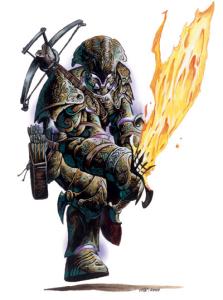
The Helmed Horror is probably one of my favorite monsters of my favorite monster book. I first saw these guys in Baldur’s Gate back in ’99, and they were terrifyingly strong. Good times. On first glance, the helmed horror is simply an animated suit of armor. But like many monsters in this book, it’s made into something much more interesting by giving it a small handful of magic abilities. Compared to true golems, it is relatively weak. But golems in Dungeons & Dragons are absolute terror beasts, so this guy is still amazingly dangerous. The main ability of a helmed horror is that it can make the blade of any weapon it holds burst into flame, covered in magic ice, or charged with lightining. It really only increases its damage by 1d6 points of damage, but it’s still an impressive looking effect that immediately tells everyone they mean business. They can also see any invisible creatures, which makes them great guardians for wizards. In addition to being made of full plate armor and difficult to hit, they are also have all the immunities of constructs and are enchanted to be completely immune to three specific spells. Usually those will be classic attack spells like fireball or lightning bolt, and while casting a spell that affects everything in a large area on a single enemy is not particularly effective, there aren’t that many other spells that can really hurt helmed horrors to begin with. As constructs, they are already immune to almost all illusions, enchantments, and necromancy spells. Disabling a helmed horror other than by hacking it to pieces is quite the challenge. Fot added fun, it also has the spells air walk and feather fall, which make it almost impossible to use the terrain against it. Pits and barriers won’t stop it at all, and even though being a heavy suit of armor, a helmed horror is just as fast as any ordinary human. It’s a fucking Terminator.
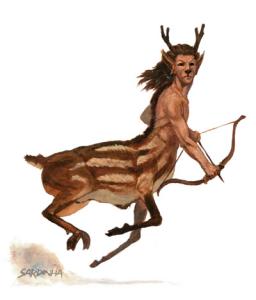
The Hybsil is one of the rare fey creatures in D&D 3rd edition, which for some reason never got much love beond the dryad, nymph, pixie, and satyr. Hybsils look like a small deer with the upper body of a small human or halfling with short antlers on their head. Though individually they are quite weak and vulnerable, they usually live in groups of several dozens and their high speed combined with their reliance on bows and arrows can make them formidable opponents. They also have the magical abilities to move without leaving any tracks and to greatly increase the distance of their jumps, which makes them amazingly well suited for ambushs. For emergencies, they also have a few magical sleep arrows they get from pixies, which can knock out many enemies instantly. They are also lead by druids and have their own rangers and sorcerers, which makes things a lot more complicated for any potential attackers. Picking a fight with any hybsils in their forest homes is much more dangerous than it looks from seeing just one or two of these small creatures.
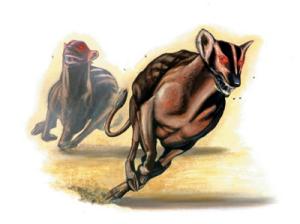
The Leucrotta is a dangerous predator based on sketchy descriptions of hyenas by the Romans. This creature simply runs with it and is exactly what was described. It has the body of an antelope, the tail of a lion, and the head of a badger, It is as large as a horse and has jaws that can even bite through armor. Leucrottas are intelligent creature and completely evil and violent. They simply live for killing. Quite surprisingly to many people, they also can talk and are very capable of immitating the voice of other animals and even people. These guys are some really viscious murder machines and that they are very able at climbing and jumping doesn’t make things better for anyone.
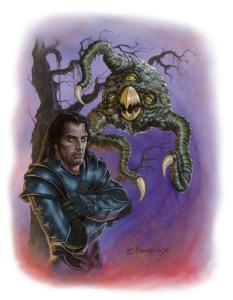
The Malaugrym are a race of alien shapeshifters from another dimension who travel through the shadow plane to reach the world of Toril. They resemble in some way both beholders and grells, but are almost always encountered in the guise of a human or other humanoid creature. However, if they want to they can take the shape of pretty much anything. Other than that they have no really remarkable abilities, but are often high level wizards or rogues. To be frank, their description here sucks. These are clearly enemies from some novel, who probably have a complex and interesting background, but the creature presented here really is just a shapechanger that can change into anything.
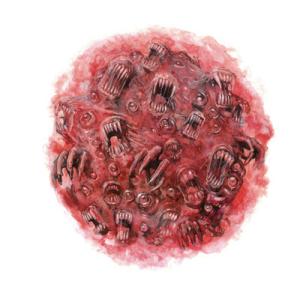
A Nishruu is a mistlike creature that feeds on magic. While intelligent, they do not talk and can not be mentally controlled in any way. Any spell targeted at them has no effect and simply makes them grow larger and when it is in contact with magic items it drains or temporarily disables them. When they come into contact with a spellcaster, the spellcaster loses prepared spells ever round. The only thing that can really hurt them are fire and cold spells, which it can not absorb. The idea is quite interesting, but fighting them is probably going to get very frustrating for players. Slaying one would likely require a small expedition and trying lots of different methods, but I don’t see how they could slay one as a regular wandering monster in a dungeon if they don’t already know what can kill it. Still, as the centerpiece of an adventure a nishruu might be a pretty interesting opponent.
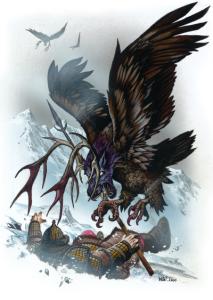
The Peryton is one of the truly bizarre creatures in D&D, and it won’t be a surprise to anyone that it originally appeared in the Fiend Folio (though with all the weird stuff in that book, it doesn’t really stand out much). I think it’s actually a creature from Greek myth, and a hyper-violent intelligent bird monster seems just the kind of critter they would love. Fits right next to harpies, sirens, and erinyes. A peryton is a large eagle with the head of a wolf and the antlers of a stag. It hates everything and only wants to kill and take the heart from its victims. It’s not particularly interesting, but probably can make for a nice addition to any adventure.
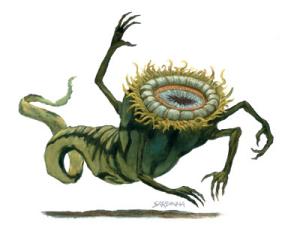
The Phaerimm are the Forgotten Realms reply to the Greyhawk weirdness that is beholders, mind flayers, and aboleths. These huge flying worms not only look bizarre, they are also extremely intelligent and powerful sorcerers. They appeared way back in the book FR13: Anauroch, but only became really relevant in late 2nd edition. They are the ancient enemy that destroyed the wizard empire Netheril by turning its land into the Anauroch desert, forcing the Netherese to flee to all corners of the world. While the Netherese were a pretty big deal, I wouldn’t be surprises if many Forgotten Realms fans have never heard of them. Native to the Underdark, they are a race of evil overlords who even enslave mind flayers and beholders within their domain. Fortunately, one of their enemies created a magical barrier that trapped the phaerimm in a large section of the Underdark, which know about matches the area of the Anauroch desert on the surface above.
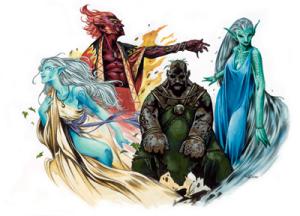
Like tieflings and aasimar, Genasi are humanoids who are descended from magical creatures from other worlds. Instead of demons or angels, the ancestors of genasi are usually genies or other somewhat humanoid elemental creatures. Genasi first appeared in the Planescape book Planewalker’s Handbook, but to my knowledge the setting never really did much with them. I think probably because it focused much more on the dozens of heavens and hells, while the elemental planes always played a relatively minor role. For reasons completely unknown to me, genasi were picked up a few years later in the Forgotten Realms campaign setting book for 3rd edition, even though they didn’t really have any role in this setting before. While they never were huge, genasi really were mostly Forgotten Realms creatures in 3rd edition, but got even more appearances in 4th. There really isn’t much to say about them. They have a small bonus to one ability score which is compensated by an equal penalty to another score, and they get a laughable tiny bonus to resist spells of their element and a single spell they can cast one per day. Crunch-wise they completely suck, but I really love the idea of people who have the blood of spirits in their ancestry which comes from the elements instead from angels or demons. And while the illustration in this book is pretty bad, there are plenty of really great ones in other books.
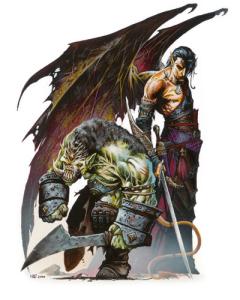
The book also has two unique types of tieflings. The Fey’ri and the Tanarruk. Both are connected to the fortress Hellgate Keep, which makes me strongly suspect that they are from the same adventure or novel. The Fey’ri are the descendants of an ancient elven family that tried to increase the magical strength of their bloodline by interbreeding with succubuses. It worked, and the first generations resulted in half-fiend elves, with their later offspring being fey’ri tieflings. Eventually the demonic elves where discovered and mostly destroyed, but a few survived and disappeared for centuries. And now they are back. Fey’ri mostly have the abilities of both elves and tieflings, but also can change their shape to appear like normal elves and have a few additional magic powers, which vary by individual. I personally really like these guys. Evil demonic elves! I can’t really defend my position here, because every single element seems totally cliched and overdone. But they don’t only work as substitute emo-vampires, but also as really cool decadent Sword & Sorcery warlocks.
The tanarruk are creations of the demon rulers of Hellgate Keep, who bred them from lesser demons and orcs. Despite their much more savage look, they are actually smarter than normal orcs and a lot tougher. As a nasty surprise, they have a very high resistance against fire and also some immunity to magic, which makes them really well suited as shock troopers to charge at enemy wizards.

I wonder if the Phaerim were inspired by the Flying Polyps from Lovecraft’s “Shadow out of Time”. They seem very similar in appearance, abilities, and even historical role.